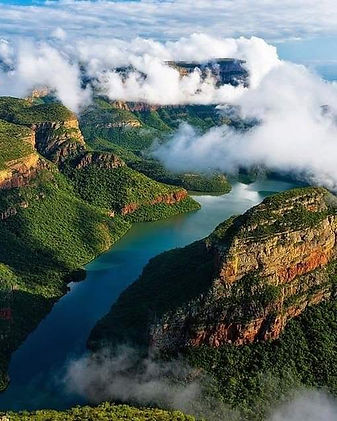Panorama Route
The Panorama Route is one of South Africa's most scenic drives, offering breathtaking views and a range of natural wonders in the Mpumalanga province. Stretching from Graskop to Hazyview, this route showcases the stunning landscapes of the Blyde River Canyon region, making it a must-see for anyone exploring the area. Below is a detailed description of what you can expect on the Panorama Route.

Highlights
1. Blyde River Canyon:
-
Description: One of the largest canyons in the world, Blyde River Canyon is a breathtaking geological wonder carved by the Blyde River. Its lush green cliffs and unique rock formations create dramatic scenery.
-
Lookout Points: Key viewpoints include God’s Window, which offers panoramic views over the canyon and the Lowveld, and the Three Rondavels, three distinctive peaks resembling traditional African huts.
2. God’s Window:
-
Description: This viewpoint offers a spectacular vista over the lush green escarpment and the lowlands below. On a clear day, you can see all the way to the Kruger National Park and the distant Drakensberg mountains.
-
Hiking Trails: There are walking trails leading through misty forests filled with ferns and diverse flora, providing an immersive nature experience.
3. Bourke’s Luck Potholes:
-
Description: A remarkable geological feature formed by the swirling waters of the Blyde and Treur Rivers. The potholes are deep, cylindrical hollows carved into the rock, surrounded by fascinating rock formations.
-
Activities: There are walking paths and viewing platforms to enjoy the natural beauty, and it’s a great spot for photography.
4. Drie Rondawels:
The Drie Rondawels are one of South Africa’s most iconic natural landmarks, located in the breathtaking Blyde River Canyon in Mpumalanga. These majestic rock formations resemble traditional African rondavel huts, with their rounded, hut-like shapes crowned by lush vegetation.
-
Scenic Beauty:
-
Towering over the expansive Blyde River Canyon (the third-largest canyon in the world), they offer panoramic views of cliffs, deep gorges, and the winding Blyde River below. The vibrant hues of red, brown, and green make them a stunning natural masterpiece.
-
-
Geological Significance:
-
The formations were sculpted over millions of years by erosion. They are composed of quartzite and shale, with their distinctive shapes formed by differential weathering of harder and softer rock layers.
-
-
Cultural Connection:
-
The Drie Rondawels are sometimes referred to as "The Chief and His Wives," with the largest peak symbolizing Chief Maripi Mashile, a 19th-century leader, and the smaller ones representing his three wives.
-
This adds a rich cultural and historical dimension to their significance.
-
-
Accessibility:
-
Situated along the famous Panorama Route, the Drie Rondawels are a must-see for travelers. A viewpoint offers a fantastic vantage for photography and quiet reflection.
-
The Drie Rondawels are not just a geological wonder but a place of immense beauty and inspiration, making them a highlight of Mpumalanga's natural treasures.
4. Lisbon Falls:
Lisbon Falls, located in the heart of Mpumalanga along the renowned Panorama Route, is one of the most spectacular and tallest waterfalls in South Africa. Cascading dramatically down a sheer 94-meter drop, this natural wonder is a must-see for nature lovers and adventurers alike.
-
Breathtaking Beauty:
-
The falls are set amidst lush green vegetation and rugged cliffs, creating a postcard-perfect scene.
-
The water plunges into a crystal-clear pool below, surrounded by serene natural landscapes.
-
-
Geographical Significance:
-
Lisbon Falls is part of the Blyde River Canyon Nature Reserve, a region rich in biodiversity and geological wonders.
-
Its height and power make it one of the most impressive waterfalls in the region.
-
-
Historical Naming:
-
The falls are named after the nearby Lisbon Farm, established by Portuguese settlers during South Africa’s gold rush in the late 1800s.
-
-
Accessibility and Experience:
-
Easily accessible, the falls are a short detour from the main Panorama Route.
-
Visitors can enjoy scenic viewpoints, picnic spots, and trails that lead to closer views of the cascading water.
-
Lisbon Falls is a captivating destination that offers a sense of tranquility and awe, standing as a testament to the natural beauty and rich history of Mpumalanga. It’s an essential stop for anyone exploring the wonders of the Panorama Route.
Activities Along the Route
Hiking and Nature Walks: Several trails along the Panorama Route cater to various fitness levels, allowing visitors to experience the region’s natural beauty up close.
Cultural Experiences: You can learn about the local culture and history, including the traditions of the indigenous people, the Shangaan and the Tsonga.
Wildlife Viewing: Keep an eye out for wildlife, including various bird species, monkeys, and sometimes larger mammals near the canyon and forested areas.
Practical Tips:
Best Time to Visit: The route is beautiful year-round, but the late afternoon light enhances the scenery, making it a great time for photography. Spring (September to November) and autumn (March to May) offer pleasant temperatures and vibrant colors.
Driving Conditions: The roads are generally well-maintained, but always check for local conditions and road safety.
The Panorama Route is a perfect blend of stunning landscapes, fascinating geological formations, and opportunities to connect with nature. It’s an unforgettable journey that complements your safari adventures in the Lowveld region beautifuly.
Want To Book?
